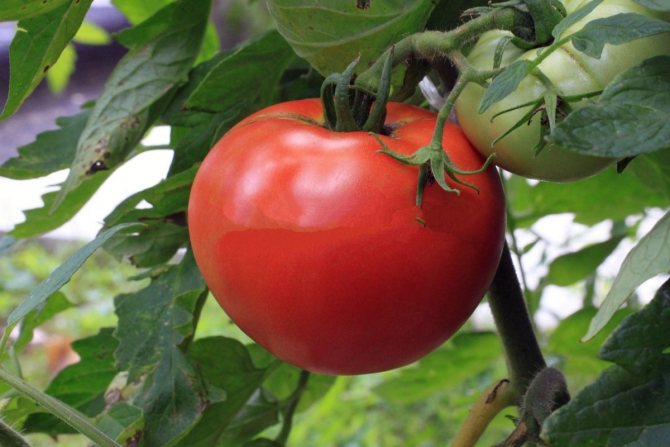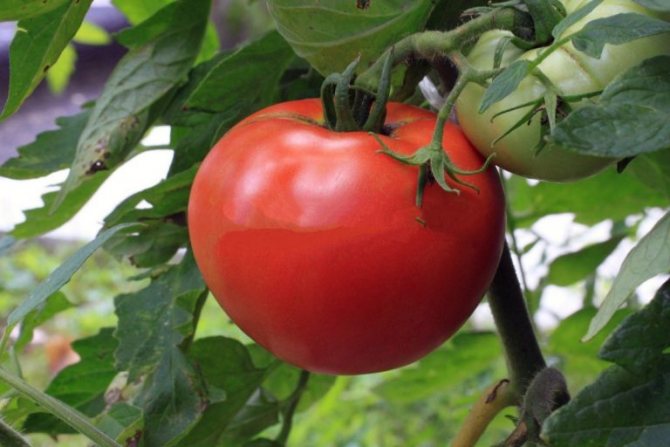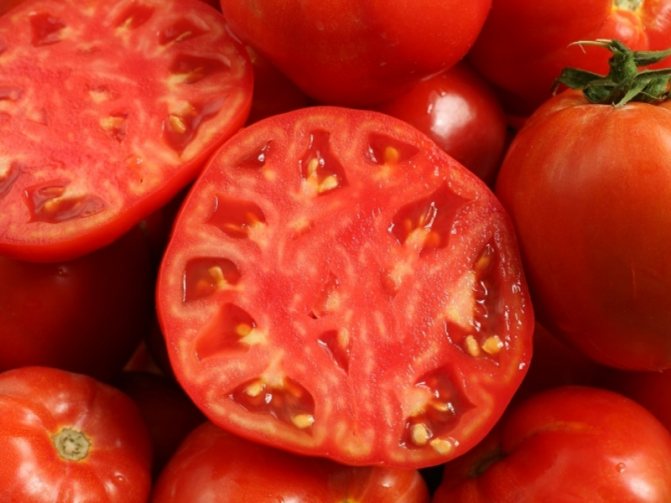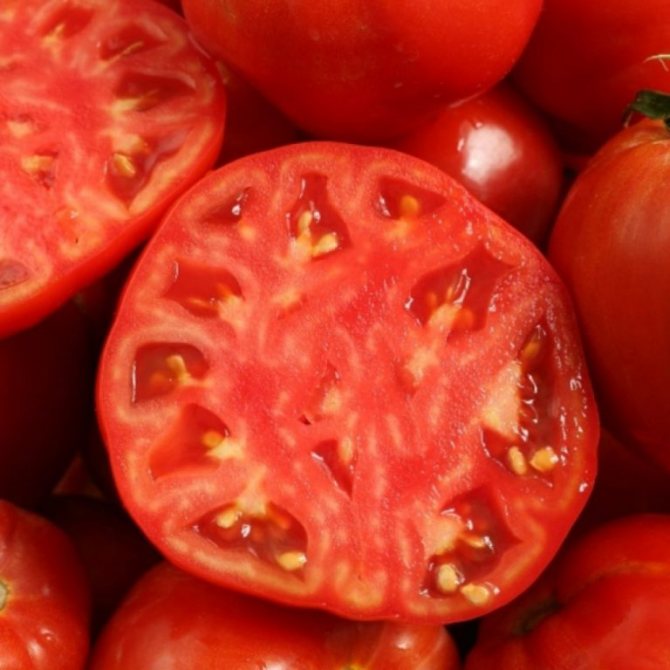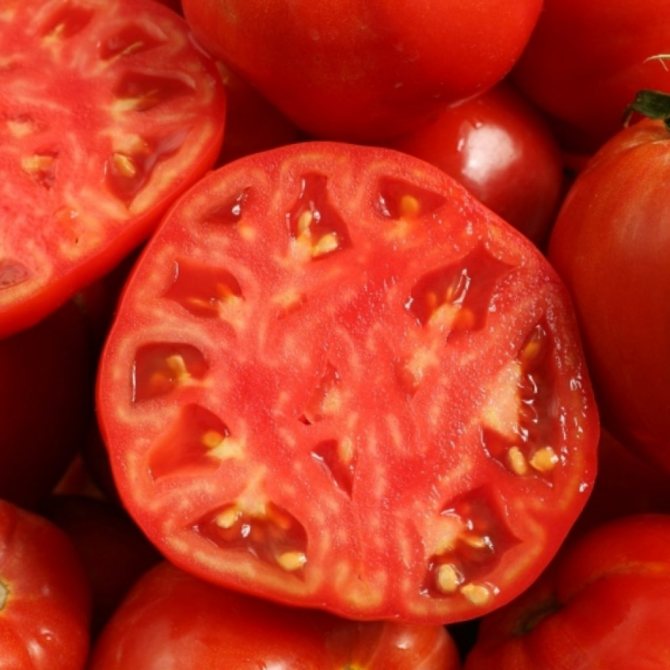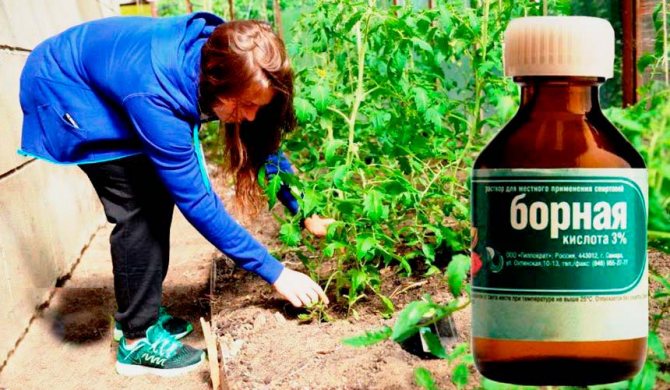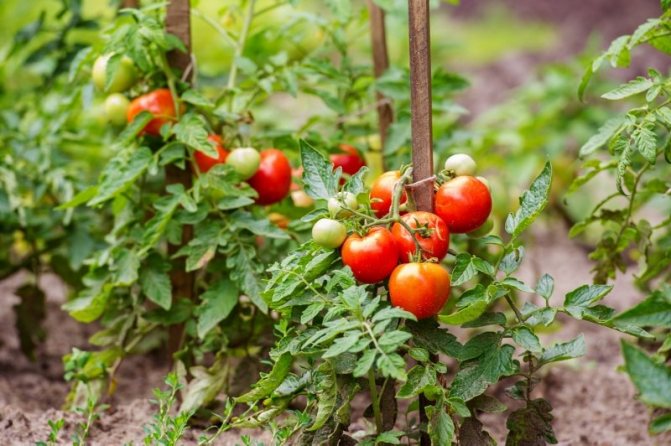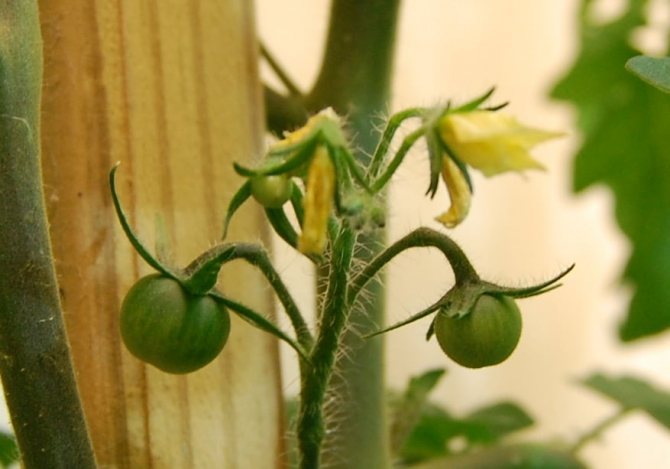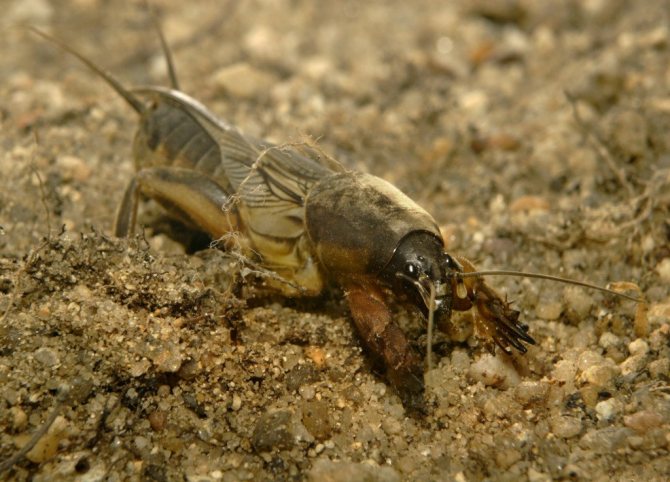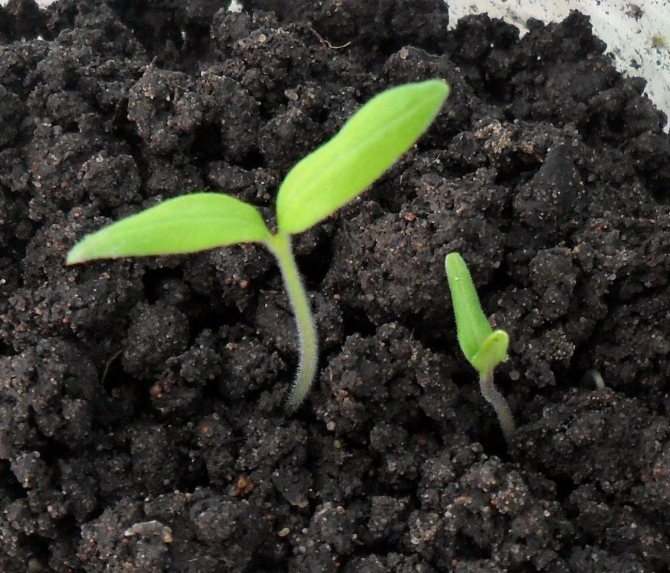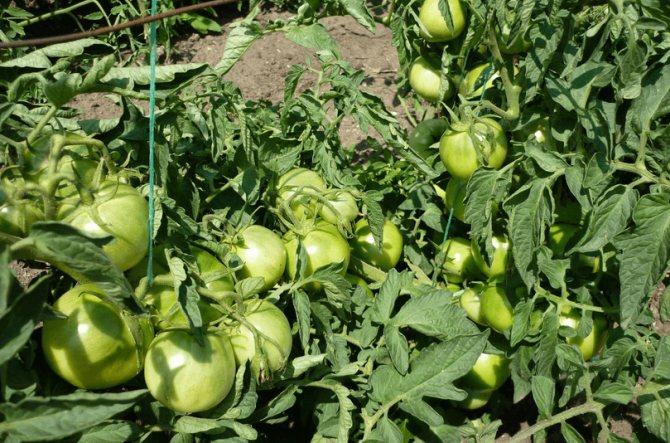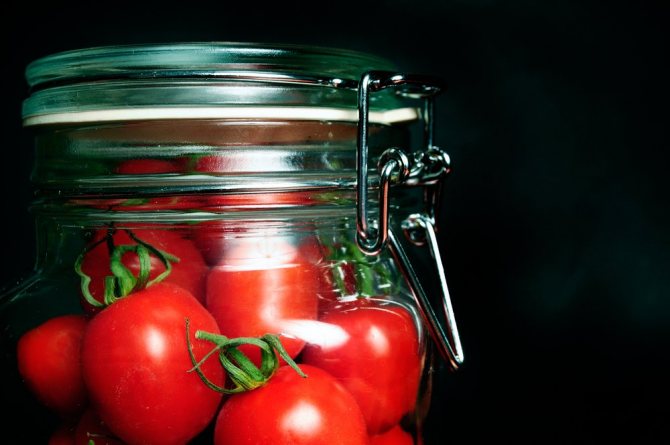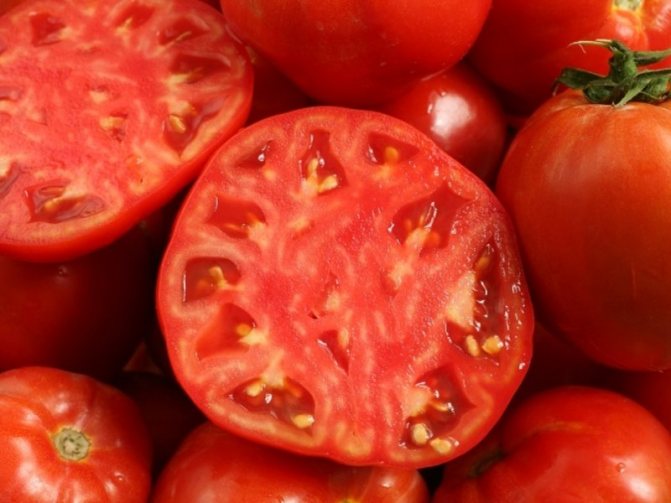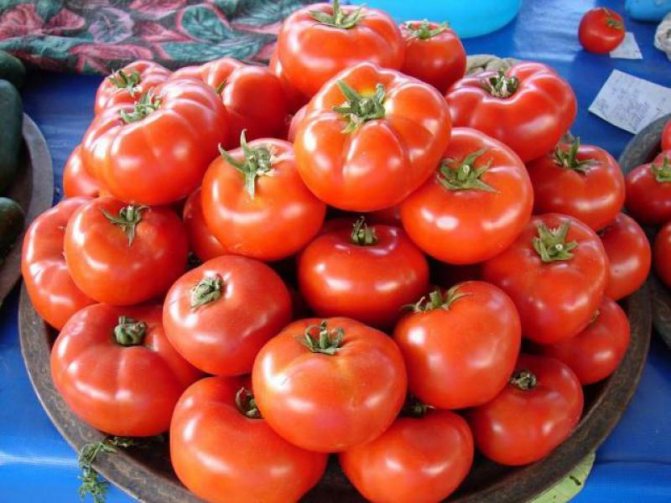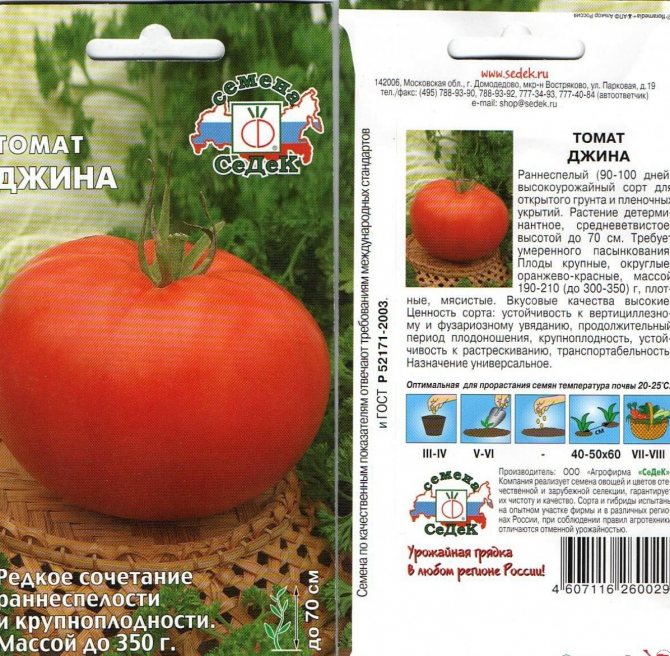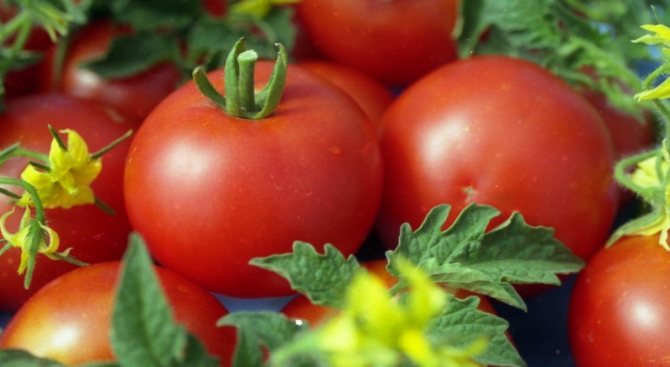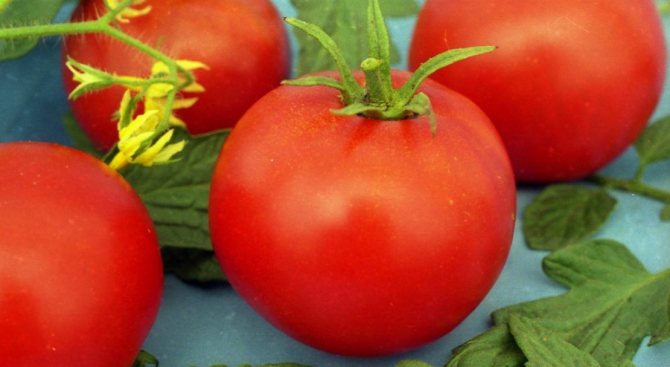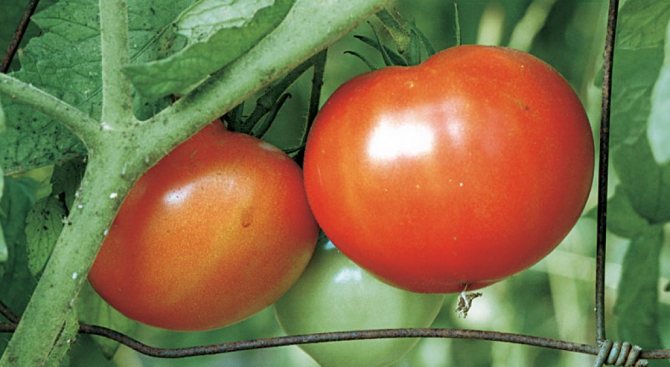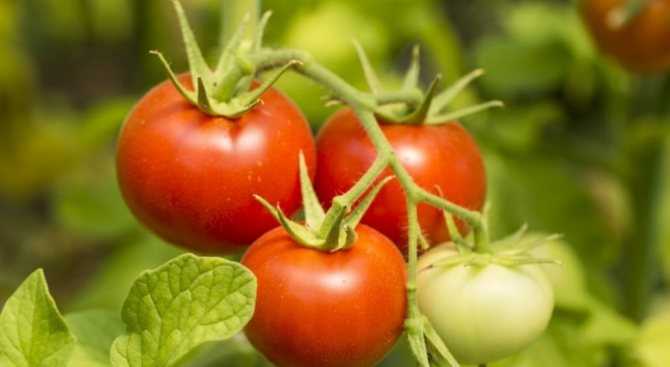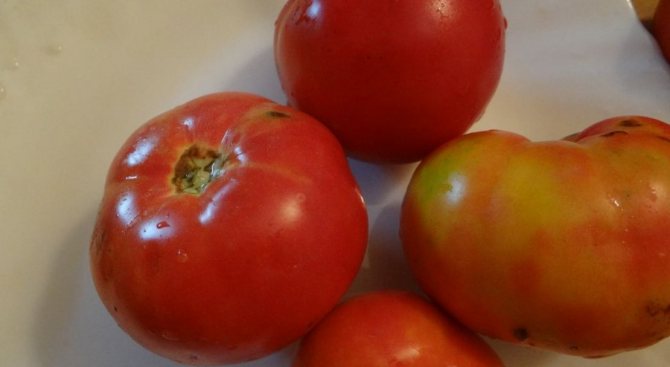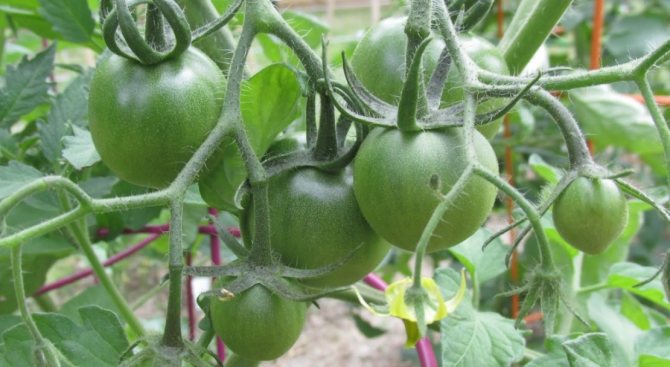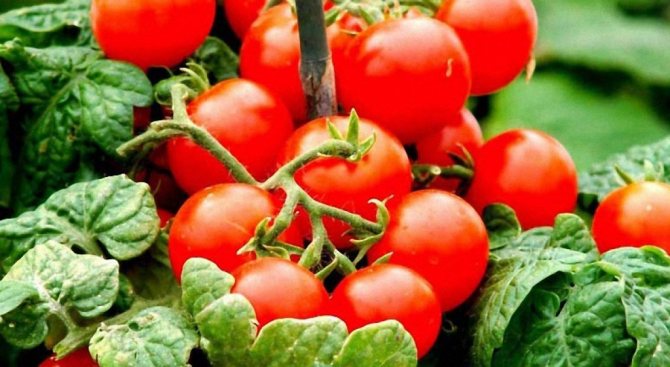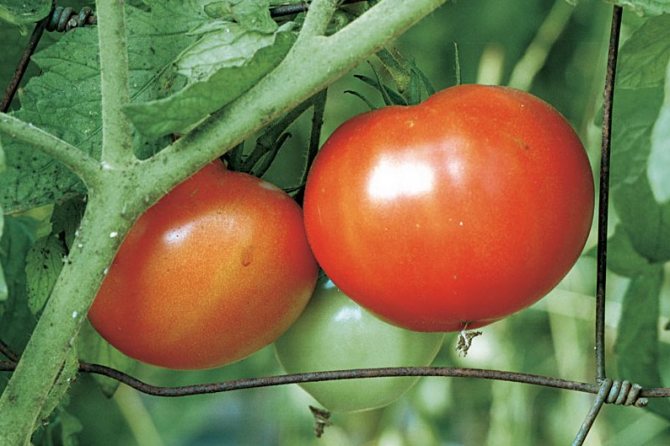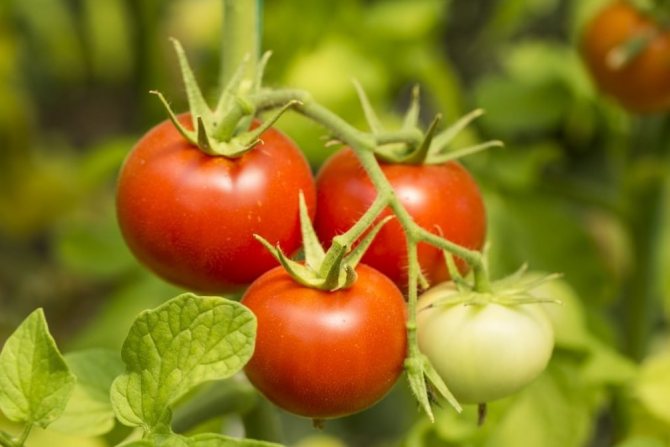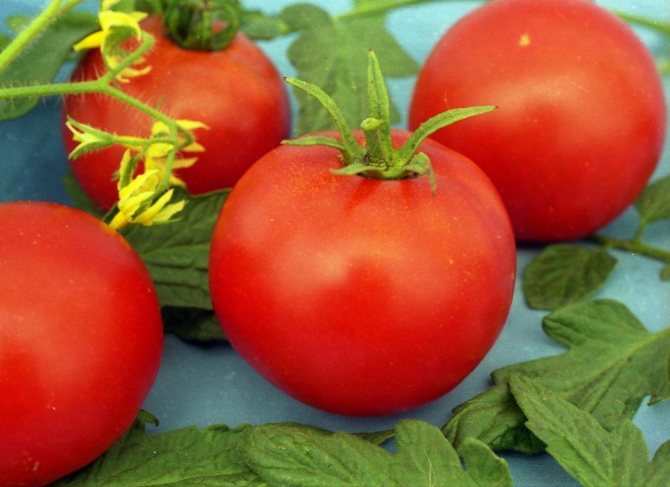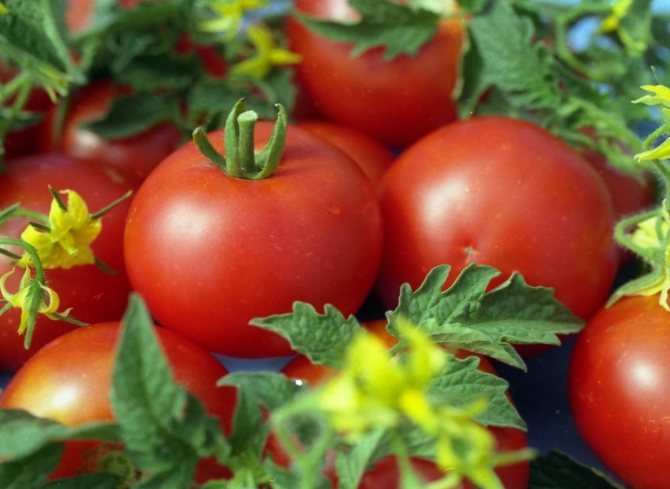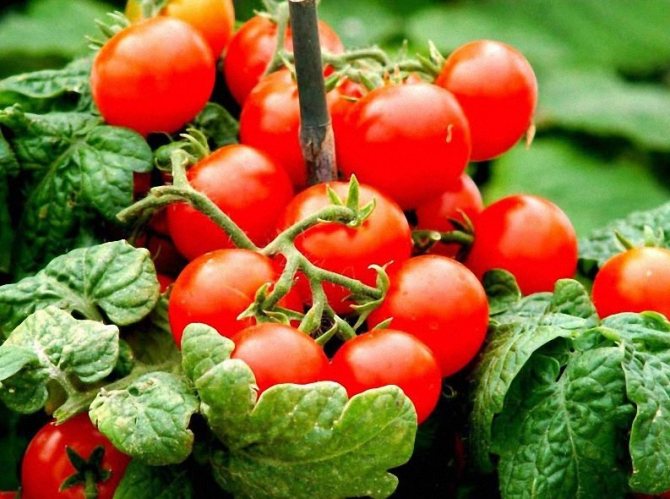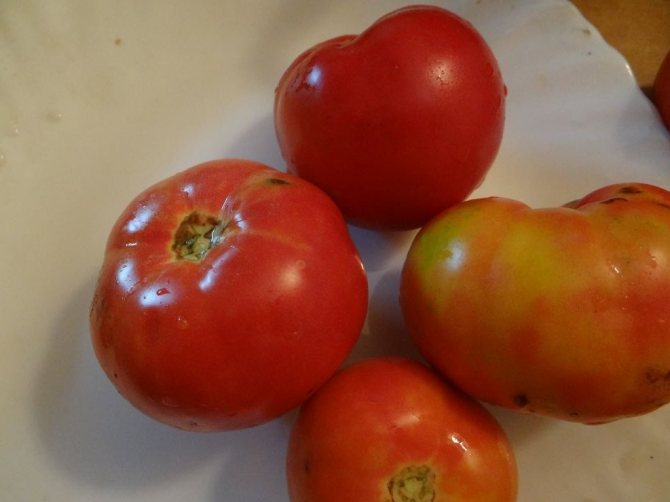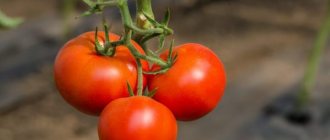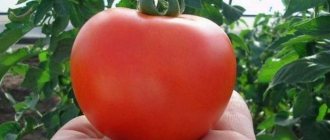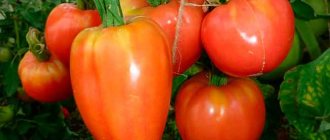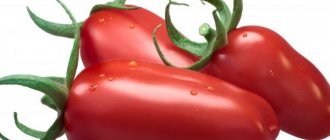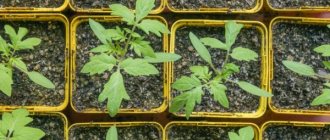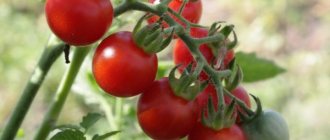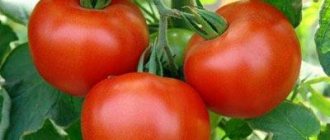Every experienced gardener tries to find a new fruitful tomato variety. It is important that the plant is easy to care for, resistant to pests and diseases. What is important is good fruiting in any climatic conditions. European breeders have developed an excellent tomato "Gina", description and photowhich can be found in this article.
Also read: how to grow tomatoes in a greenhouse
Description of the variety, characteristics
The Gina variety is early, determinant. Plant height 50-60 centimeters.
The leaves are large, dense, green in color. The bush is medium-leafy, does not require tying, pinching and garter.
The first inflorescence is formed above 8-9 leaves. The inflorescences are simple. 3-6 fruits are formed on one hand. Average weight is 200 grams.
When grown in a greenhouse, a greenhouse, the fruits reach 400 grams. The shape is slightly ribbed, spherical, slightly flattened on top.
Unripe tomatoes are green. Ripe fruits are bright red, juicy, dense, consist of 6-8 chambers. The skin is dense and thick. The taste is rich, sour-sweet. The aroma is pleasant. Mass fraction of dry matter is 5 percent.
Advantages and disadvantages of the variety
The Gin variety has many advantages, but in turn, several disadvantages can be noted.
Dignity
- The variety has a harmonious, balanced combination of taste, sugar and acid. Gina, regardless of the method of cultivation, always gives a stable, abundant and high-quality crop.
- About 10 kilograms of tomatoes are removed from one square meter. Some gardeners, with proper care, remove up to 23 kilograms of fruit.
- The plant does not need pinching, pinching and garter. The variety is lush, low, in hot climates it covers the roots from the sun.
- The variety is suitable for growing in open ground and greenhouses, greenhouses. In the open field, harvesting is stretched until the first frost. When grown in a heated greenhouse, the fruit can be harvested all year round.
- The variety is resistant to many diseases and pests. Gina's tomato is not susceptible to verticillium, late blight, fusarium, root rot and viral diseases of tomatoes.
- Fruits have a dense pulp and strong skin, easily tolerate transportation. Tomatoes do not lose their appearance and are perfectly stored. They are grown both in private farms and on an industrial scale.
- Due to their large size, tomatoes are not suitable for canning. In turn, they make delicious salads. From the fruits, a very tasty juice is obtained, which can be consumed immediately or prepared for the winter.
- Gina is a varietal tomato and allows you to collect planting material for the next year.
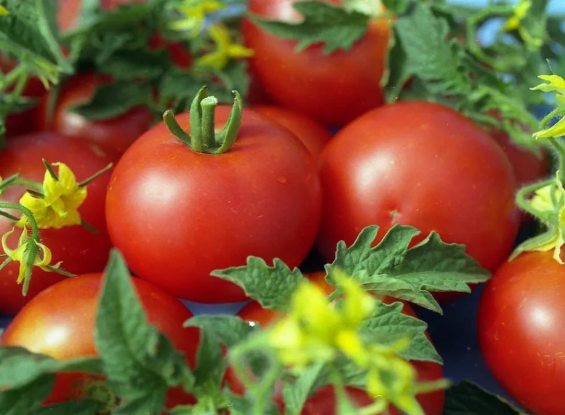
disadvantages
The plant reacts poorly to temperature changes and requires shelter when it gets cold. The temperature at night should not drop below 16 degrees. If the temperature indicators fall below these indicators, the plants freeze and begin to hurt.
The bush grows strongly. If the ovary is more than 4 fruits, the stems may lie on the ground or even break. At the same time, placing the stems on the ground saves the roots from heat and weeds.
Diseases and pests
Judging by the description, Gin's tomato hardly suffers from nightshade diseases. He can get the greatest damage from pests - aphids, Colorado potato beetle and bear.
- Aphids are an insect that feeds on plant sap. Because of this, tomatoes cease to grow, bloom and set fruits. Aphids also carry viral and fungal diseases. Chemical preparations "Biotlin", "Askarin" and "Iskra" help to fight the pest. As a preventive measure, you can burn the remains of plants, dig up the ground in the fall and cultivate it with karbofos in the spring.
Otherwise, there are no special problems with growing Gin's tomatoes.
Features of growing and care
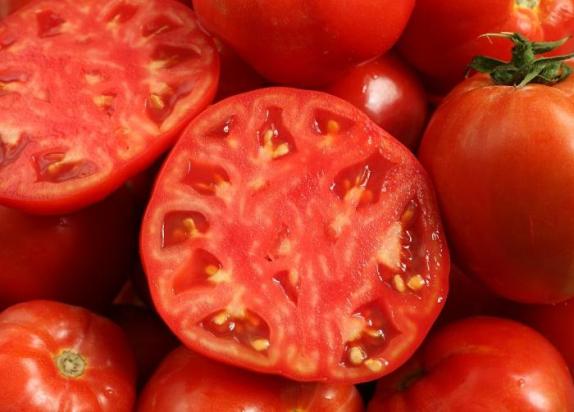

Tomatoes of this variety are grown in a seedling and non-seedling way. The seedless method is used in warm climatic conditions. A bright place is selected for sowing. There should be no stagnation of moisture on the site. The ground should be loose and breathable.
When grown by seedlings, seeds are sown in late February - early March (with further planting under a film, in a greenhouse) or in April (when planted in open ground).
- For sowing, take wooden boxes, containers, pots.
- The soil should be loose, air and water permeable.
- A layer of film is laid at the bottom of the box, holes are cut to drain excess water.
- A thin layer of river sand, fine gravel for drainage is poured onto the bottom. There is soil from above.
- There should be at least 2 centimeters of free space to the top of the box.
The soil can be bought universal for vegetable crops or made from turf soil, sand, humus, peat and coconut substrate. All components are taken in equal parts. The mixture is thoroughly mixed and sieved on a coarse sieve.
The finished soil mixture is spilled with a solution of potassium permanganate and remains for 2 days indoors. Sowing soil should be moist, but not soggy.
Before sowing, the seeds are soaked for 2 hours in a warm, weak solution of potassium permanganate, then dried. To accelerate germination, the seeds can be additionally soaked in a solution of any growth stimulant.
Seeds are sown 1-3 centimeters apart. A thin layer of earth is sprinkled on top. Watering is done from a spray bottle.
To accelerate germination, the container with seeds is covered with foil or glass. After sowing, the container with seeds is exposed in a warm place. The first shoots appear in a week. The shelter is removed.
With a dense planting, when the first 2-3 main leaves appear, the plants are picked into separate containers with a diameter of at least 10 centimeters. If the planting is not dense, planting is carried out when the plants grow up to 5-6 leaves.
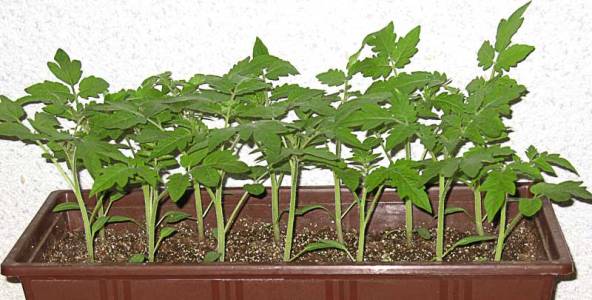

The soil should not dry out, but waterlogging can lead to the death of sprouts. Seedlings are irrigated at the root or in a tray. Excess water from the pan must be drained.
To protect against black leg, the seedlings are dusted with wood ash, ground or colloidal sulfur.
Top dressing for the entire period of plant growth in indoor conditions is carried out no more than 2 times before transplanting into open ground. For feeding, you need to take mineral and organic fertilizers. The first feeding is done 10 days after seed germination, and the second time 2 weeks before planting in the ground.
In open ground, seedlings can be planted in 45-50 days.
It is better to prepare the land for planting tomatoes in the fall, but if this has not been done, preparation is done a couple of weeks before transplanting the plants into the ground. Mineral fertilizers with phosphorus and potassium, and wood ash are applied to the ground. The soil is dug up and loosened.
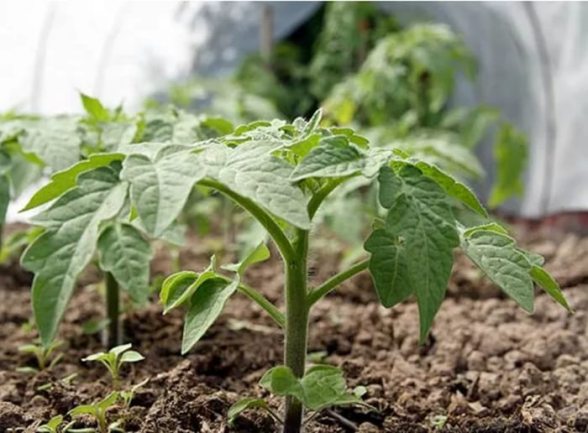

Disembarkation is made in pits or in rows, staggered. There is a gap of 40-50 centimeters between each bush. 3-4 bushes are planted on one meter.
Seedlings are rolled into a hole together with an earthen lump, if the earth has crumbled, the roots are neatly distributed in the hole. The seedling is deepened to the cotyledonous leaves and compressed with earth. After planting the bushes, the seedlings are watered with settled, warm water.
After planting in the ground, you need to regularly weed, fertilize, loosen and water the soil.
Saplings form 2-3 stems from the root. The lower leaves are periodically cut to protect against pests and diseases. This pruning improves ventilation of the roots.
With the seedless method, sowing seeds in open ground is done in late spring or early summer.
For sowing, grooves are prepared 30 centimeters in length. Ash and potassium-phosphorus fertilizers are poured to the bottom. Sod soil is poured on top, everything is watered with settled water.
After, you need to prepare pits with a depth of 2-3 centimeters. When sowing, a gap must be observed between the seeds for free plant growth. 3-4 seeds are distributed in the pits, they are sprinkled with earth. To protect it from drying out and weeds, the soil is covered with mulch. With the threat of frost, the pits are covered with a film.
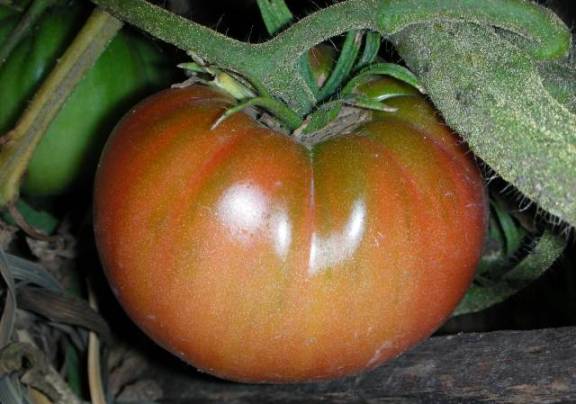

Further care consists in watering, removing weeds and treating plants from pests.
Watering is done twice a week (under the roots). During the formation of the ovary, fruiting, you need to water the bushes every other day. If the air temperature exceeds 29 degrees, then you need to water the plants daily. When watering, water should not fall on the leaves, as this leads to plant disease.
Top dressing is done during the ovary and fruiting of tomatoes. Fertilizers are applied every two weeks.
The period of fruit ripening from the period of emergence of the first shoots takes 110 - 120 days.
Fruiting is not amicable, extended, long-term. The fruits are harvested before the first frost; when grown in a greenhouse, the harvest is carried out year-round.
Seeds are harvested from the largest, ripe fruits.
The Gina variety is resistant to viral diseases of tomatoes, root rot, fusarium, late blight and vercillosis wilt, but there are pests that can harm plants.
The tomato is susceptible to aphid damage. In case of yellowing and curling of leaves, the appearance of a sticky liquid, protective measures must be taken. For protection, you can use chemical preparations (Confidor maxi, Decis profi, Ratibor), soap solution or decoctions of wormwood leaves, onion and garlic husks.
When a bear appears in the soil, the roots of the plant are affected, which leads to disease and death of the tomatoes. The affected plant stops growing, begins to wither, the leaves turn yellow and eventually fall off. To combat the pest, preparations in granules are used (Rembek Granula, Medvetox). The product is buried in the soil.
The Colorado potato beetle can be exterminated with the help of drugs: Senpai, Confidor, Corado, Decis Extra.
When a wireworm appears, such means are used as: Zemlin, Bazudin, Antichrushch.
This variety is unpretentious and high-yielding. Many gardeners, having tried to grow it at least once, leave room for it from year to year.
How to grow tomato seedlings yourself
In regions with warm climates and mild winters, the plant can be grown without going through the seedling stage, sowing directly into the ground. For other climatic conditions, preference is given to the seedling growing method.
Did you know? In the forests of South America, wild tomatoes are still found, the fruits of which weigh about 1 gram.
Optimal timing for sowing
If you plan to grow in a greenhouse, then sowing seeds is carried out at the end of February. For outdoor cultivation, sowing seedlings is recommended in early April.


The soil
For germination of seedlings, you need to prepare a light soil with good moisture permeability and looseness. For the composition, several components are taken:
- sod land - 2 parts;
- peat - 1 part;
- humus - 0.5 parts;
- sand - 1 part.
Before sowing, the soil is calcined in the oven. After the procedure, he should "come to his senses", stand for about a day.
Important! Please note that when calcining, the soil must be sifted and moistened, the temperature in the oven must not exceed +90 ° C, the time must be 30 minutes.
Growing tank
For germination of seedlings, wooden boxes, containers of an elongated, rectangular shape are suitable. At the bottom, it is imperative to make holes for moisture drain and lay drainage (fine gravel).
Seed preparation
Before the process, the seeds are soaked in a slightly pink solution of potassium permanganate for 2 hours. The floating pacifiers are removed. The remaining material is treated with "Epin" for better germination.
Sowing seeds
Sowing is carried out in slightly moist soil. Sowing scheme:
- distance from each other - 2-3 cm;
- depth - 0.5 cm;
- the soil should be 2 cm below the top edge of the box;
- sowing is sprayed from a spray bottle;
- cover with foil.
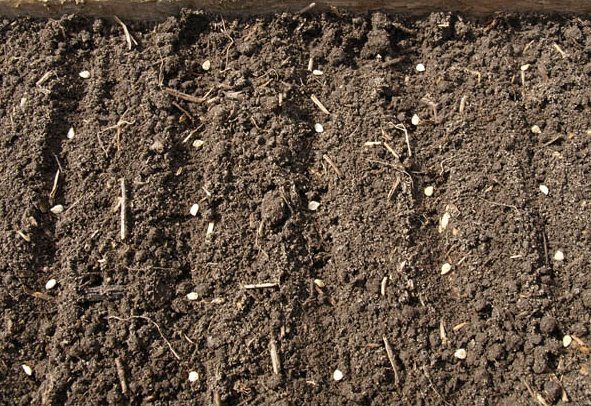

Seedling care
Immediately after sowing, a high temperature of + 25 ... + 28 ° C is ensured. After emergence, the film is removed. Daylight may not be enough, so you need to provide additional (phytolamps). Daylight hours for crops should last up to 14 hours.
Watering the sprouts is carried out as the soil dries up in the box. They are fed every twice with nitrogen-containing compounds. The first fertilization - 14 days after sowing, the second - after another 14 days. A good complex suitable for tomatoes is Agricola, you can use a urea solution in a proportion of 1 tbsp. l. substances per 10 liters of water. In separate containers, the bushes are transplanted in the presence of 5-6 leaves.
Important! Other plants of the nightshade family are bad predecessors for culture, since they are susceptible to the same diseases.
Hardening of seedlings
One and a half weeks before transplanting, the seedlings must undergo a hardening procedure. The box with plants is taken out into fresh air for 1-2 hours. Gradually, the "walk" time is increased, 2-3 days before transplanting, the seedlings should "feel" calmly in the air and at night.
Gina's tomato: video
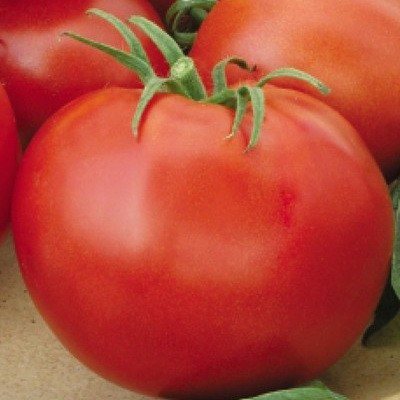

I sowed Gin's tomato directly into the ground, since there was not enough time for growing on the windowsill, this method turned out to be the most convenient. The first harvest pleased with its size. The average fruit weight reached 250 grams. The tomatoes are delicious with a characteristic aroma.
In February last year, I drove into the store for seeds and they advised me the Gin variety. According to the characteristics of the tomato seemed very good, I decided to find out if the description matches or not. The bush has grown lush. For the convenience of collecting fruits, I tied it up. The harvest turned out to be very good, the harvest lasted until October, which was very pleasing. This year I will definitely plant this variety in my garden.
Gina's tomato variety is one of new determinant tomato species - distinguished by large-fruited was bred by Dutch scientists and immediately earned trust.
It attracts with its characteristics and consistently good harvest... It is unpretentious to care for in open ground and greenhouses, it is resistant to diseases.
Producers of tomato seeds Gina on the Russian market are Aelita, Poisk, Siberian Garden, Vegetable abundance, Agros, Gavrish, Udachnye Seeds, Ural Summer Resident, Euro-seeds. Sometimes on the packs there is a difference in the description in terms of ripening (mid-ripening, early-ripening) and the color of the tomato (red, pink).For the rest of the parameters, the properties are identical.
Description of the variety and characteristics
- Gina's tomato is a determinate, medium leafing, low growing plant. The height of his bush is about 50-60 cm.
- The leaves are large, green, dense. Medium leafy bush, consists of three stems growing from the beginning of the root. Does not require a garter, pinching, pinching and forming bushes.
- The time from the beginning of the appearance of the first beginning shoots to the ripening of the fruit passes on average 110-120 days. Although in the description of the breeders, the variety is listed as medium early under special favorable conditions (greenhouses, high temperatures, hot climates), Gin's tomatoes begin to blush 85 days after the first sprouts appeared.
- Description of the tomato. Gene has a simple message. The first brush begins to form over 8–9 leaves, then after 1–2 leaves. It is characterized by uncomfortable fruiting. 3–6 fruits appear on one cluster.
- Description and characteristics of the fruits. Large, mid-season, bright red. The shape is rounded, with a slightly flattened top. The average weight of a tomato is about 200 grams, although sometimes it is 400 grams. Inside the fruit there are 6-8 chambers, 5% of dry matter by weight. The tomato has a dense, thick skin. The taste is rich, with a juicy sweetish-sour pulp and a pleasant aroma. Crack when overripe.
- Characteristics of the soil for plant cultivation. As a low-growing plant, it loves soil and is grown in the southern latitudes of the Chernozem region in a seedless way, it grows well in greenhouses in central Russia. Tomatoes are thermophilic, with temperature extremes they often suffer; when transplanted into open ground, seedlings provide additional temporary shelter. Since Gin's tomatoes have a strong root system, they can be cultivated in poor soils.
- The Gina variety is characterized by resistance to diseases such as fusarium, verticillosis, root rot, late blight and TMV.
- Tomatoes are stored for a long time and are well transported.
This variety has a Russian hybrid form - Gina TST.
Such a tomato was bred by Russian breeders. Tomatoes are similar to Gin's tomatoes, but they have their own peculiarities.
Characteristics of the variety Gina TST:
- Height reaches 65 cm, although the plant is also of a determinant type.
- Gina TST is distinguished by high branching, but also with 2-3 shoots from the stem. No more than 4–5 bushes are planted per square meter, otherwise they can "hammer" each other, which will affect fertility. It is recommended to tie the bushes to a support to prevent the collapse of the plants.
- Does not need pinning.
- Gene TCT has a medium maturity, which begins approximately 105 days after planting. When growing, it is advised to remove the lower leaves from the shoots in order to improve the nutrition of the fruits. For a good harvest, ventilate the soil.
- Fruits are round, slightly flattened with slight ribbing. Ripe tomatoes of red color and rather big weight of 230-350 gr.
- The hybrid has an average yield, up to 10–12 kg per meter.
- The hybrid variety is resistant only to Verticillium and Fusarium.
- Tomatoes are perfectly stored and transported, keeping their fresh appearance. They are used for fresh preparation; they are not suitable for preservation due to their large size.
Growing tomato gin
Tcultivation technology has features, although it is similar to other varieties of tomatoes.
The preparation describes the following steps:
- Preparatory stage: soak tomato seeds in a solution of potassium permanganate for 2 hours.
- There are two ways to plant material: seedling and seedling. In the open field, seeds are planted in prepared holes 40 * 50 in size. In greenhouses, greenhouses and at home, they are planted with seedlings.
- The seeds begin to be cooked in late February or early March. And the seedlings are transplanted into open ground, in prepared beds, at the end of May. It is believed that with two true leaves, the seedlings are ready for planting. Seedling method for Gin tomatoes is preferred.
- It is worth remembering that the transplantation of this variety occurs after uniform heating of the soil in order to protect the plant from low temperatures.
- To accelerate the development of sprouts, it is recommended to use mineral fertilizers.
- The picking takes place when the seedlings have three real leaves.
When growing the Gina variety, the following recommendations:
- Observe the crop rotation. Tomatoes are best planted after onions, carrots, legumes, salad. And do not grow after nightshade crops, eggplant, pepper.
- Plant basil, coriander, and mustard next to the beds. This is done to attract pollinating insects.
- By resorting to artificial pollination, the fertility of the plant increases.
- Before planting the seedlings, wood ash is added to the holes to fill with trace elements and protect against certain plant diseases.
- Top dressing is applied at the stage of formation of fruits and ovaries of the crop. Keep in mind that nitrogen fertilization should be kept to a minimum. An excess of nitrogen in the soil provokes the appearance of greenish spots on tomato fruits.
The varieties Gina and Gina TST have a simple growing scheme, but proper care and attention should not be neglected.
Care and protection against pests
The description of the care and protection against pests of this variety is standard and similar to the usual agro-complex methods of growing tomatoes.
- Water it twice a week. When fruiting and in hot weather, water the beds every other day or every day.
- Loosening after each watering and weeding the weeds will provide improved nutrition for the tomatoes and ensure the harvest.
- In hot climates, a garter is not made.
- Gin's tomatoes have determinant, compact bushes and therefore do not pay special attention to pinching. But we need high-quality timely feeding of the plant according to the following scheme. Fertilize for the first time 2 weeks after planting the greenery in the permanent place of promise. The next one is after 10 days, then again after 2 weeks. And 20 days after the third feed. Watering during this period is increased. Tomatoes are fed with mineral fertilizers and herbal infusions. To increase the sugar content of the fruit pulp and to protect the bush from pathogenic microflora, it is recommended to water it with a weak solution of potassium permanganate three times a month.
- When fighting insect pests, chemicals and traditional medicine are used.
Tomato variety and hybrid gina bear fruit well with simple agrotechnical care, even at home.
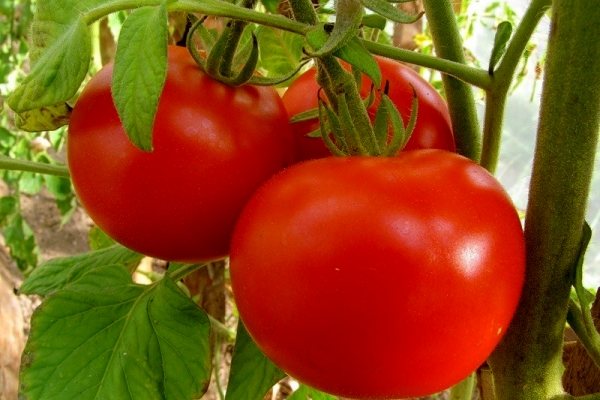

Even in difficult weather conditions Gin's tomato planted in the garden will provide seven tomatoes... A successful variety both in terms of the external characteristics of the fruit, and in terms of resistance to fungal infections (as described). When grown outdoors, Gin's tomatoes ripen well on the vine, which annually increases the circle of fans of this variety.
How to care outdoors
Culture care is not difficult. It is advisable to pinch off the lower leaves as the bush grows, which, in contact with the soil, can rot or be affected by bacteria.
Watering
Plants are watered at the root 2 times a week up to 2 liters per bush. Use water at room temperature, settled, better collected rainwater. In intense heat, watering is carried out more often, while it must be remembered that moisture that has fallen on the foliage, evaporating, will leave a burn. It is better to water in the evening when the sun is not so active.
Important! Fresh droppings or manure are not applied under the tomato. Such a land is oversaturated with nitrogen, all the strength of the plant will go into the growth of foliage, restraining fruiting.
Top dressing
During the period of active growth, the plants are fed with nitrogen fertilizers. Most often used:
- ammonium nitrate;
- urea;
- herbal infusion.
It is enough to pour 0.5 l of fertilizer under the root, dilute the active substance with water 10–20 g per 10 l. With the beginning of the formation of ovaries and during the period of flowering, fruiting, plants need potassium and phosphorus. During flowering, it is recommended to fertilize with Azophos, and during fruiting - with a mixture of 10 liters of water:
- potassium sulfate — 15 g;
- superphosphate - 15 g;
- urea - 10 g.
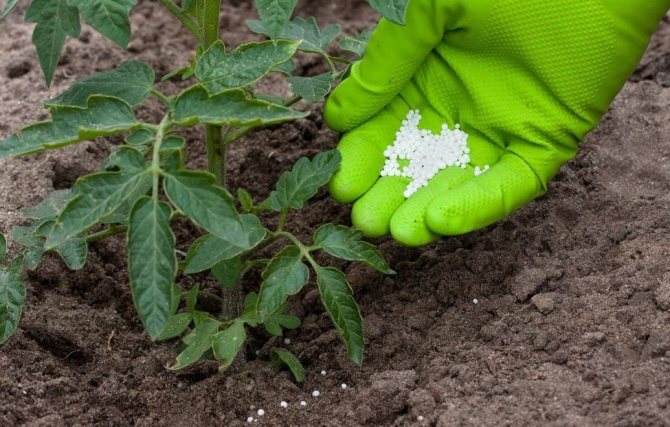

Feeding frequency:
a) vegetative period:
- the first - 2 weeks after planting;
- the second - after 10 days;
- the third - after 2 weeks;
b) flowering:
- the first - during the formation of ovaries;
- the second - after 2 weeks.
During the fruiting period, fertilize no more than 2 times a month.
Stepping
The culture does not need pinching, the only thing that can be done to prevent diseases is to regularly cut off the lower leaves. There is also no need to form a trunk, since the plant forms into three stems on its own.
Did you know? The tomato is used not only for food. In the production of some perfumes, the aroma of the foliage of the plant is added to the bouquets.
Soil care
The roots need access to oxygen, so the soil is loosened regularly. In order for the plants to receive enough moisture and nutrients, weeds must be removed. If the gardener does not have enough time for regular watering, you can cover the soil with mulch. The benefits of this procedure:
- retains moisture;
- inhibits the growth of weeds;
- prevent overheating of the roots.
Used as mulch:
- peat;
- sawdust;
- straw.
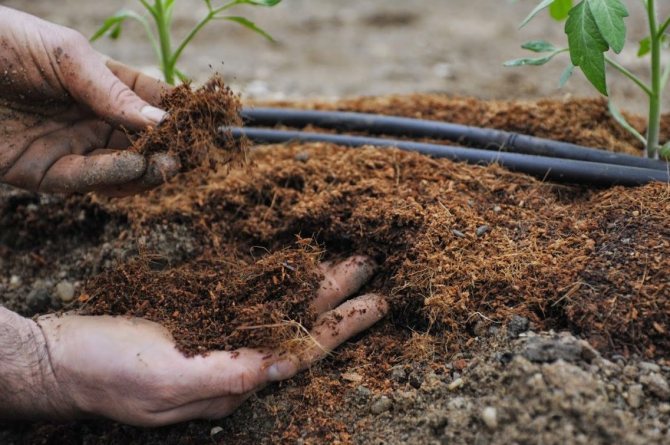

Tying a bush
Gina's tomato is a large-fruited crop; under the weight of the fruit, the stems can break. To prevent this from happening, the plants are tied up. Since the variety is undersized, the garter is carried out at the stage of fruit formation, under the fruiting branch. For this, an individual support (wooden peg) is installed and tied with a thin twine.
Find out why the leaves turn yellow on tomatoes.
Tomato characteristic
Gina is a determinant variety, independently stops growing after the formation of 8 brushes. In the exhaust gas, the height of the bush is about 60 cm. The growth of tomatoes planted in a greenhouse can exceed 1 m.
The bush is weakly branched (unstamped), strong, there is no need to pinch. The descriptions indicate that the variety does not require a garter... But in practice, a bush without support can collapse due to the simultaneous pouring of a large number of fruits.
The fruits can be categorized as dessert tomatoes, as they have a dense pulp with a good, harmonious taste. The shape of the fruit is beautiful, round.
The color is saturated, red... The skin is dense, smooth. The fruits do not crack, gain weight up to 200 g. The largest ones weigh almost 300 g. The bush with ripening tomatoes is very decorative.
With proper care, the bush yields a crop in a short time. The productivity of the grade for exhaust gases is good. 10 kg of tomatoes are removed if the planting scheme of 4 plants per 1 sq. m.
The purpose of the fruit is universal... Tomatoes are good for canning, you can pickle cut tomatoes: they do not fall apart, retain their shape and color. Sauces and ketchups from this tomato variety are thick and tasty.
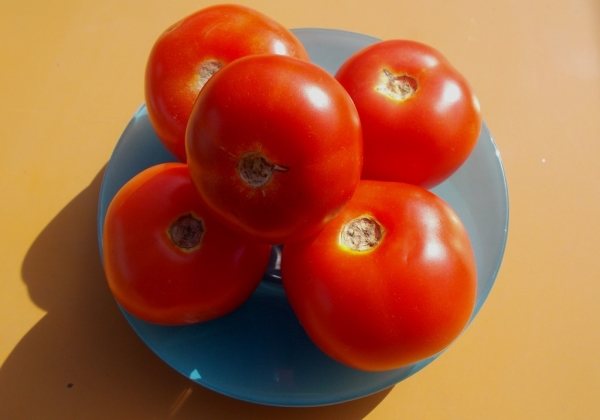

The purpose of the fruit is universal, it can be attributed to dessert varieties
Characteristics of the subspecies
Read the description before choosing a Gin tomato variety. What is unique about the Gina tomato variety, its characteristic suggests that their ripening falls on the 120th day after planting. But this is only if the seedlings were planted. This variety has a lot in common with the Sedek and Login species. Tomatoes are spherical and weigh about 280 grams. It is possible to get from three to six fruits from one branch.
In the description of tomatoes it is indicated that from 1 square meter you can get a yield of 10 kilograms. Not only the characteristic gave the plant popularity, but also the incredible taste of its fruits. Thanks to the combination of sour and sweet, we have obtained versatile tomatoes that can be used in various fields.
The gin tomato has a small bush. In height, it can reach a maximum of 60 centimeters. From one seed, a seedling grows, from which three stems are released. This variety does not need garter or shaping.Gina is a thermophilic plant, so it grows well in the southern regions.
Health Benefits of Tomato
Gin's tomato pulp can be called healing due to the high content of vitamins and minerals. You can bring health benefits, strengthen it in the summer by eating tomatoes in fresh or processed (juice, puree) form.
Tomatoes are useful for men after 40 - prevention of adenoma. Lycopene, an antioxidant found in tomatoes, reduces the risk of cancer cells.
Beautiful, tanned skin is every young woman's dream. The chance of getting a tan of a beautiful golden hue increases with regular consumption of tomatoes.
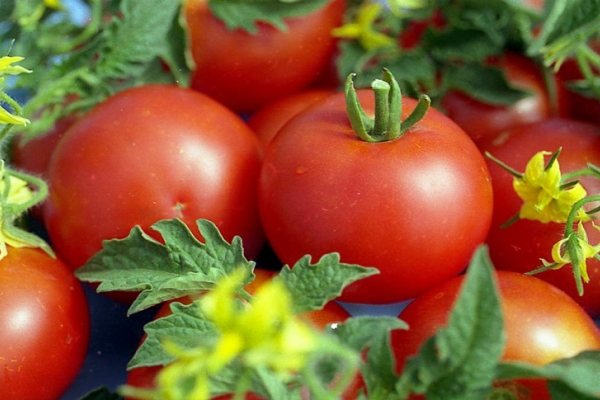

Tomatoes are useful for hypertensive patients, men over 40
Variety reviews
Sergey: “I planted Ginu for the first time two years ago. Since then I have been planting them every year. I don't plant a lot, there are 10 bushes. The collected tomatoes are enough to eat and to make adjika for the winter. "
Irina: “I planted Gina in the OG and in the greenhouse. The result obtained in the OG was more satisfying. The bushes turned out to be strong, all covered with tomatoes, which were sung very quickly. I did not pinch, but tied to the support. The bushes fell over from the weight of the fruit. I believe that the variety behaves perfectly in the south of Western Siberia. "
All stages of planting tomatoes in the ground
In warm regions (southern Russia), this variety of tomatoes can be grown using a seedless method. In the middle lane and in Siberia - only through seedlings.
Seedless method
The seedless method makes tomato cultivation easier. Sow seeds when the soil warms up, spring fluctuations of night temperatures pass. Dig up the ridge for sowing in advance. She must stand for several days.
For digging for each square meter of the ridge, you can add:
- ash - 1 tbsp.;
- superphosphate - 2 tbsp. l;
- humus - 1 bucket.
On each square meter of the ridge, form 4 holes with a diameter of 35 cm. Spill the holes with warm water. When the earth settles, put 3-4 seeds per hole. Sprinkle with humus.
Before sprouting, water the wells with a small amount of water... When the tomatoes sprout and grow stronger, remove the weaker sprouts or transplant to another ridge.
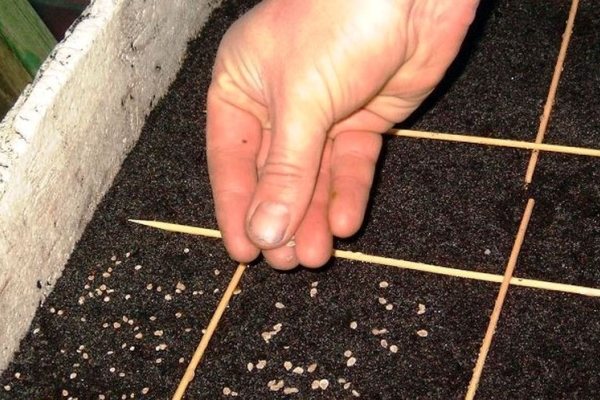

Sow seeds when the soil warms up, sprinkle with humus
Seedling method
If you plan to plant tomatoes in the OG in mid-May, then seeds are sown in March... In Siberia, you can sow in April, as seedlings are planted in the ground in early June.
You can sow seeds in plastic containers with lids. Use high quality commercial primer, ready to use.
Level the earth, water. Spread the seeds at a distance of 3 cm from each other. Cover with 2 cm of soil. Close the container and place in a bright place for germination.
As soon as the real leaves appear, cut Gin's tomato into separate cups. Grown seedlings plant in the ground according to the scheme: 4 plants per 1 sq. m.
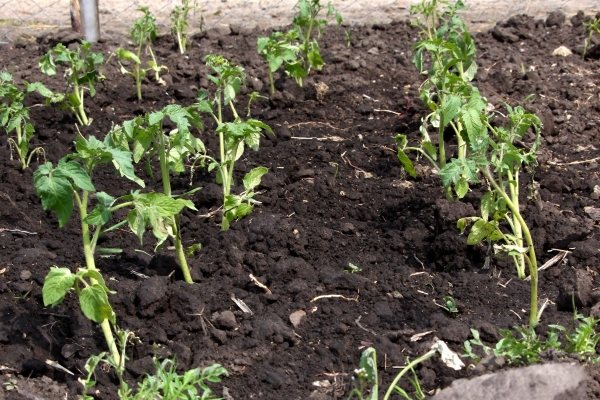

Seeds are sown in containers in March, in May, seedlings are planted in open ground
Growing secrets
We use iodine to increase yields... Add 5 drops to one bucket and mix. Water at the root of 2 liters per plant.
Speeding up maturation with superphosphate... You need 1 tbsp. l. Dissolve fertilizers in a small amount of water (1 tbsp.), let stand for 2 days. Then pour the concentrated fertilizer into a bucket of water and spray the tomatoes with this solution.
Gina variety is one of the best among low-growing, large-fruited tomatoes for exhaust gas. An unpretentious, productive variety can be recommended for novice gardeners.
Care features
No need to pinch Gina's tomato, the bush is recommended to be formed into 3 trunks. The main care, in addition to weeding and loosening the soil in the aisles, is reduced to watering and top dressing.
You need to water abundantly... The frequency depends on soil and weather conditions. The ideal watering option is drip, otherwise - at the root.
During the season, carry out at least four root dressings.
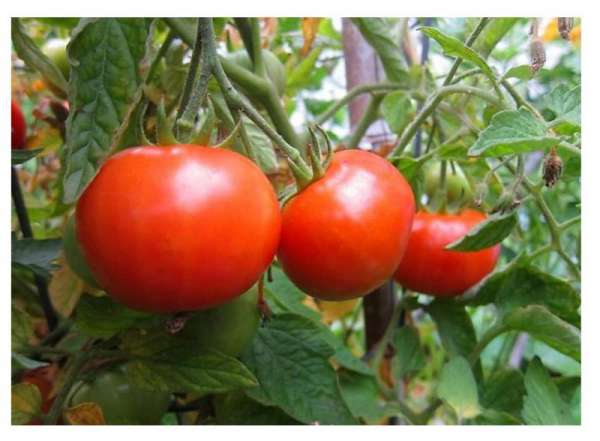

When choosing tomato seeds for planting, almost every gardener first of all pays attention to the characteristics of the variety. After all, I want to grow a productive, disease-resistant and unpretentious variety. And sometimes breeders really create varieties that meet almost all the wishes of gardeners. For example, Dutch specialists have bred Gin's tomato, which in a short time became known throughout the tomato world. And the variety is also good in that the next year's harvest will grow from the collected seeds, which is in no way inferior to last year's.
Description of Gina tomato variety
The Gina variety is rightfully considered an outstanding achievement in the field of tomato breeding. The popularity of the variety in our country is evidenced by the fact that several well-known breeding and seed companies in the country are selling Gina seeds at once:
- Gavrish;
- Successful harvest;
- SeDec;
- Aelita.
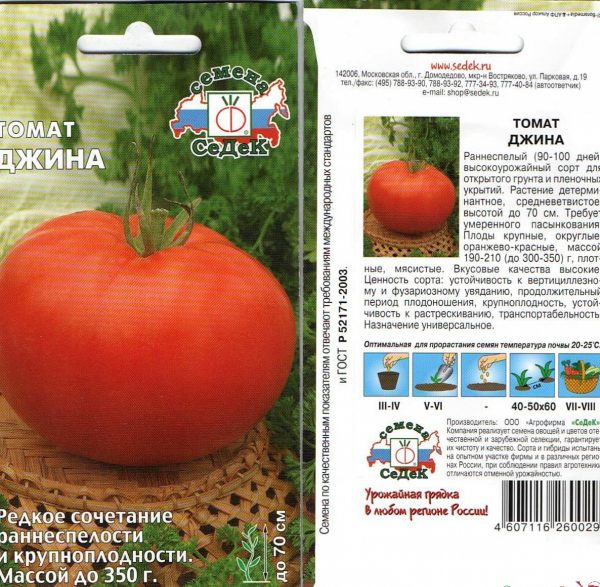

Gin's tomato seeds are in high demand
Gina is a short, or determinant plant, up to 60 cm high. In greenhouse conditions, the growth is slightly higher - 80 cm. The plant does not belong to the standard plant, but it has a strong structure. In the process of growth, it independently forms 3 stems, which is why the bush looks sprawling. Average leafiness.
The first fruit cluster is formed after 8 - 9 leaves. And then they are tied in 1 or 2 sheets. Up to 5 fruits can be tied in one brush.
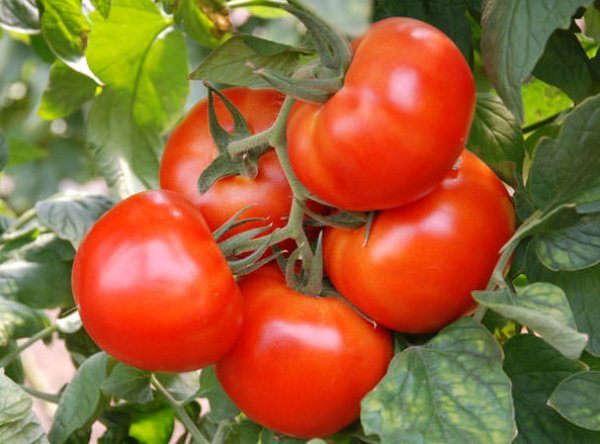

Fruit cluster of Gina's tomato bears up to 5 pretty fruits
The fruits are rounded and slightly flattened. Slight ribbing is sometimes noticeable. Quite large in size - 200 - 250 g, sometimes 300-gram fruits are found. Ripe tomatoes are bright red. The skin is very firm. Gin is appreciated for its fleshy, juicy and aromatic pulp. The dry matter mass in fruits reaches 5%. The taste of tomatoes is sweet, although a slight sourness is still caught.
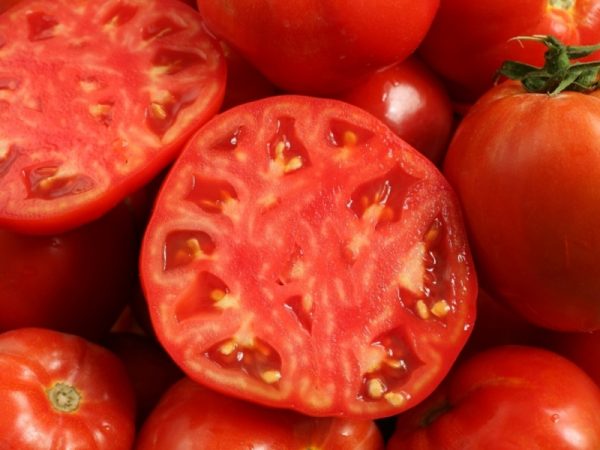

Gin's tomato pulp is juicy and fleshy, the taste is wonderful
Video: an overview of the Gina tomato variety
Characteristic
The set of excellent characteristics of the Gina variety made it popular not only in our country. These tomatoes are appreciated by gardeners in Europe and Asia.
- From the moment of germination to ripening of the first fruits, 110 - 120 days pass. Therefore, Gina is a mid-early variety.
- Gina is very fruitful. Up to 3 kg of fruit can be obtained from a bush, and from 7 to 10 kg are removed from 1 m². In the greenhouse, the yield is increased.
- Fruiting is extended. The fruits are set and ripen gradually.
- The dense skin is an undoubted plus of the variety, since thanks to it the tomatoes are well stored and withstand transportation without losing their commercial qualities.
- The fruits of universal use. Salads with fresh tomatoes will bring health benefits. The variety produces wonderful juice, ketchup and tomato paste. The strong skin allows the fruit to be preserved.
- The variety can be successfully grown both outdoors and indoors.
- Gina's immunity is excellent. The variety is resistant to fusarium, late blight, root rot and other diseases.
- The variety is plastic, adapts well to environmental conditions. This makes it possible to grow it in all regions of Russia.
- It does not require pinching, which makes it easier for the gardener.
- Gina is not a hybrid, but a varietal tomato. This allows you to independently collect seed and plant it next year.
If ripe Gin tomatoes are rolled into sterilized jars, then the shelf life can be extended to 3 months. But you need to store such jars in a cool place in the complete absence of sunlight, for example, in a refrigerator or basement.
Advantages and disadvantages of the Gina variety - table
Pros and cons
Gina's tomato has many positive characteristics.
- Among the advantages of the variety:
- high productivity;
- long fruiting period;
- resistance to major diseases of nightshade crops;
- good transportability;
- culture does not require pinching, bush formation;
- excellent taste;
- varietal tomato: its seeds are used for planting.
- Some disadvantages of the variety are also noted:
- thermophilicity of culture: reacts sharply to temperature changes;
- too large sizes are not in all cases convenient for canning;
- despite good immunity, it is attacked by insects.
Comparison of varieties of Gina and Gina TST
A tomato with a very similar name has recently appeared on the market - Gina TST. It is not a clone or a hybrid. This is a completely different variety belonging to the Russian selection. There are similarities in the description of the characteristics of the two varieties, but there are also differences:
- Gina TST matures a little earlier than Gina;
- also suitable for all regions of Russia, and is recommended by the State Register for growing in open ground and under film shelters;
- Gina TST bush of the determinant type;
- the fruit is round, loose and slightly ribbed;
- weight - 200 g;
- the number of seed nests can be up to 6;
- the taste is excellent;
- thin skin does not allow storing and preserving tomato;
- indoor yield - up to 6 kg per 1 m².
Comparative characteristics of varieties Gina and Gina TST - table
Features of growing varieties of Gina
Since Gina can be grown outdoors, under plastic cover, and in a greenhouse, planting methods vary.
- the seed method is used exclusively in the southern regions;
- seedling - in cooler ones.
By the way, it is the seedling method that is popular in all regions, even the southern ones, because it allows you to get an earlier harvest. And for the Gina variety, this is important, since the ripening period of the fruits is extended, and can last until the very cold. Tomatoes planted with seedlings give off the bulk of the crop much earlier.
Seed method
Seeds are sown only in heated soil. They are soaked before sowing. The sunniest place is chosen for planting, since Gina will not grow in the shade. Dig shallow holes into which a little wood ash is added. The seeds should be buried by 2 cm. To protect the soil from drying out, the bed is covered with agrofibre or foil. In addition, the shelter creates favorable conditions for the rapid germination of seeds.
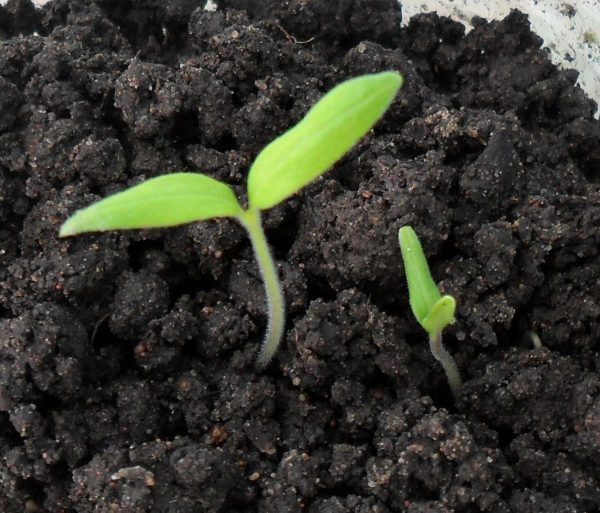

Several seeds are sown in one hole at once, in order to then leave the strongest seedling
Seedling method
Seeds are sown in seedling boxes at the end of March. In the southern regions, sowing is done a little earlier so that the seedlings do not overgrow. Seed material does not require preliminary preparation, except for soaking. After the appearance of 1 - 2 true leaves, the seedlings dive into separate containers. In the process of growth, seedlings are fed 2 - 3 times.
Seedlings are transplanted to a permanent place at the age of 50 days. The soil should warm up to 15 ° C. Usually suitable conditions come in May, in the southern regions - at the end of April. If the weather conditions are unstable, the seedlings are planted under a temporary shelter.
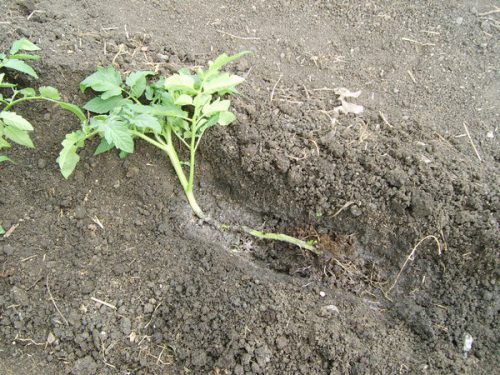

If the tomato seedlings have outgrown, they are buried lying down, with their roots to the south.
Shaping and garter
There is no need to form and pinch the bush, the breeders have taken care of this. The plant independently forms 3 - 4 shoots, due to which the load on the bush becomes uniform.
If Gina pluck out all the side shoots below the first fruit cluster, then you can get a harvest ahead of schedule.
Due to its short stature and strong structure, the bush can not be tied up. Often, Gina's shoots are simply allowed to sink to the soil surface, which helps retain moisture in the roots. But such an experiment can be carried out only in the southern region, where precipitation is extremely rare in summer. Many gardeners still recommend tying up fruit brushes. This will protect the fruits from possible damage due to increased dampness, and keep the tomatoes clean.
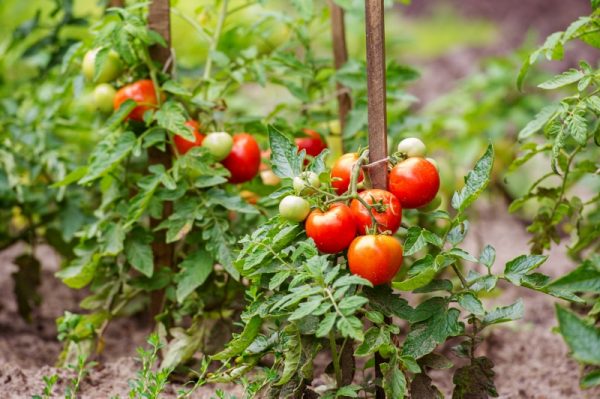

Despite the short stature, it is still better for Gin to tie it up, so the garden will look neater and the fruits will not get dirty
Planting scheme and how to protect bushes from thickening
The plant, although not tall, is quite spreading. Therefore, from 3 to 4 bushes are planted on 1 m². The landing pattern might look like this:
- the distance between the bushes is 50 cm;
- row spacings are placed every 65 - 70 cm.
To keep the gina from thickening and to provide the fruits with maximum light, you need to remove all the leaves that shade the ripening tomatoes.
Watering and feeding
Gina prefers moderately moist soil, which is provided by infrequent but abundant watering. If the soil is excessively moistened, the quality of the fruit suffers. They become watery, a prerequisite for the development of fungal diseases arises. With insufficient watering, when the ground dries out strongly, there is a danger of the ovaries falling off.
An approximate watering schedule is once a week. But it must be corrected by the presence or absence of precipitation. Watering rate - 7 - 8 liters under a bush. To prevent water from burning the green parts of the plant when moistened, watering is carried out in the evening. If it's cloudy outside, you can water during the day.
When the Gina bushes are in bloom or have begun to set fruit, watering should be more abundant.
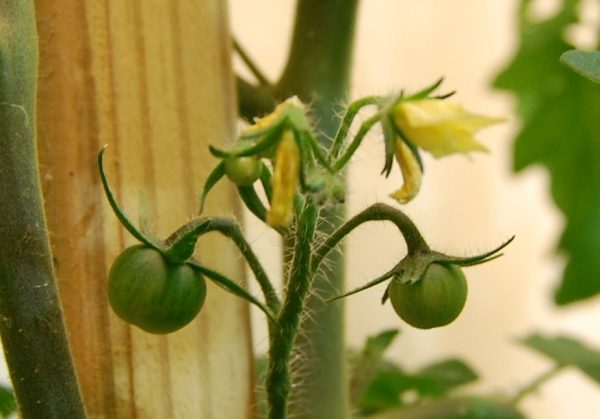

When the tomato begins to bloom and set fruit, it is time for abundant watering.
When seedlings are planted, nutrients must be added to the hole:
- 1 tsp phosphorus-potassium fertilizers, such as superphosphate;
- 1 tsp ash.
It is not recommended to add nitrogen when planting - this element can reduce the immunity of a tomato. But ash is necessarily used, as it contains potassium, which increases immunity. For the rest, fertilizing for Gin's tomato is no different from a similar procedure for other varieties.
On Gina, a large number of ovaries are tied to prevent them from falling off, the bush is treated with a solution of boric acid. For this, 1 g of boric acid is dissolved in hot water (but not boiling water). Spraying is carried out when the solution has completely cooled down. For processing, choose either evening or morning hours. Consumption rate - 1 liter per 10 m².


Boric acid is a very useful drug, as it participates in many important processes in the tomato from the moment of planting.
How to protect Gina from diseases and pests
Prevention is the key to successful cultivation. Everyone knows that disease is easier to prevent than to cure. Therefore, despite the good resistance of the Gina variety to diseases, it is recommended to carry out the treatment preventing the development of the disease in time.
The first processing of seedlings is performed 2 weeks after planting in the ground. And then repeated procedures are carried out every 14 to 15 days. Each gardener probably has a list of drugs, the reliability of which he does not doubt. Well, for beginners, let's compose a hint:
- from fungal infections, the most common are copper sulfate and Bordeaux liquid;
- systemic drugs that act not only outside, but also inside the plant include Quadris and Ridomil Gold;
- you can use biological fungicides - Gaupsin, Trichodermin or Fitosporin.
Gina is less resistant to pests. Aphids, wireworms, bear, larvae of the May and Colorado potato beetle can pose a particular danger. For the purpose of prevention, various means can be used:
- folk - infusions of plants with a pronounced odor, for example, garlic or wormwood. Onion peel decoction helps well against aphids;
- chemical - Ratibor, Confidor or Decis-pro will help to cope with the aphid invasion. the wireworm and the beetle larvae will not resist the Antichrusch or Bazudin;
- Colorado potato beetle larvae will not survive treatment with Decis, Corado or Confidor;
- the bear is very dangerous. The pest is practically invisible on the surface, so the granules of Medvetox or Rembek are buried under the bush.
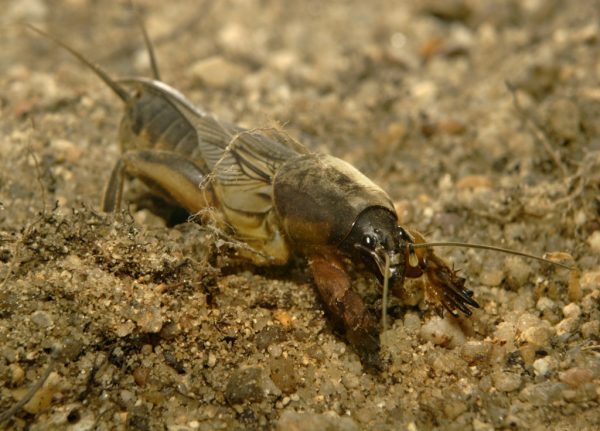

It is difficult to find the bear, since during the day it hides underground, but at night you can hear it - it makes chirping sounds, reminiscent of a cricket
Planting seedlings to a permanent place
The transplant is carried out approximately 45-50 days after sowing. The site is dug up and saturated with potassium-phosphorus fertilizers with the addition of wood ash. The place for the tomato should be protected from drafts, well lit.
Digging holes for planting, focusing on the size of the root system. Before planting, they are spilled with settled water. Landing scheme:
- the distance between the bushes is up to 50 cm;
- distance between rows - up to 70 cm;
- depth - to cotyledon leaves.
After planting, the seedlings need to be watered.
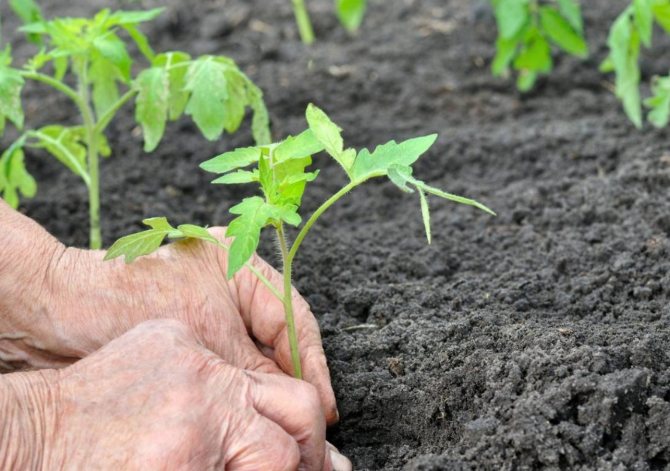

Features of growing in a greenhouse
Of course, it is better to plant Gina in an open garden under the bright sun. But in cold regions, such conditions are hardly possible. Therefore, the variety is grown in a greenhouse, where care for it changes somewhat.
- Watering control should be tightened. Indeed, in conditions of closed ground, the soil dries out much more slowly than in an open bed.
- Periodic ventilation is necessary to help avoid increased humidity.
- Greenhouse Gina will have a greater growth, which means that she must be tied up.
Otherwise, care is carried out in the same way as in the open field.
Preventive treatment
The culture is resistant to many diseases, including viral ones. But there are still cases of defeat, as well as attacks of insect pests. The main preventive measures:
- Compliance with crop rotation.
- Site cleaning before planting.
- Disinfection of soil for seedlings and seed treatment.
- 3 weeks after transplanting into open ground, the culture is watered with garlic infusion.
- During the flowering period, they are treated with an infusion of calcium nitrate - 1 tbsp. l. / 10 l of water.
- After harvesting, the soil is sprayed with an aqueous solution of copper sulfate in a proportion of 10 l / 200 g.
- Insects are often attracted to acidic soil, to avoid this, the soil is lime.
- To scare off pests and their larvae, the soil is covered with mulch, mixing the drug Bazudin into its composition.
- Repellent plants are planted along the edge of the plot and between the rows, which repel insects. When pests appear, the bushes are sprayed with a decoction of these plants.
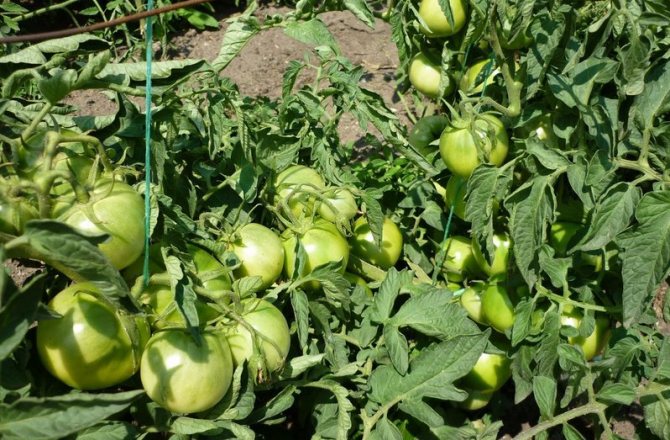

Plant repellents:
- marigold;
- nasturtium;
- tansy;
- sagebrush;
- tobacco.

